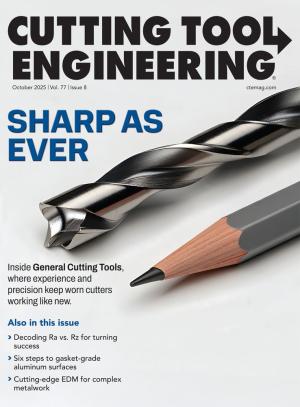Dear Doc: There’s debate in the shop whether we should balance the wheel before grinding or dress the wheel before grinding. What’s your take?
The Doc replies: Textbook grinding says that the final thing you should do just before grinding is (a) true/dress the wheel; and (b) to do so at the exact same wheel RPM you plan to use during the grinding operation. Balancing should be done BEFORE truing/dressing.
Here’s why. Balancing your wheel doesn’t actually balance your wheel. It just makes your wheel less unbalanced. When a wheel is unbalanced, the centrifugal force from the imbalance causes the wheel to pull away from the Z-axis of rotation. It causes the wheel to oscillate up and down in the Y-axis.
That oscillation creates a problem: The wheel bangs against the workpiece in the Y-axis. We fix that by truing/dressing the wheel. Now the wheel is not round, it’s egg-shaped. The wheel still has the imbalance (it always has some imbalance), but we’ve corrected the wheel geometry for that imbalance by making the wheel egg-shaped in a way that exactly corrects for the imbalance. Now, when we go to grind, the spindle still oscillates up and down in the Y-axis due to the imbalance, but the wheel has a slightly larger radius on the light side and a slightly smaller radius on the heavy side. That gives us perfect conformity between the workpiece and the wheel in the Y-axis.
What if we balance the wheel after dressing/truing? We reduce the imbalance. But the wheel is still egg-shaped for the previous imbalance condition. It’s egg-shaped in the wrong way. The result? The wheel bangs against the workpiece (in the Y-axis) until that wrong egg shape is worn away.
However, in 95% of grinding operations, none of this matters. It’s all academic. We live with the banging because it’s small. And then it goes away.
But in a few grinding operations, it does matter. An example: Grinding of small-diameter tools. Let’s take a look at what happens here, and let’s add in an additional
factor — the eccentricity added when we move the wheel from the truing spindle to the grinding spindle, even when the wheel stays on the same adaptor.
We true the diamond wheel off-machine — probably at a lower RPM than we will use during the grinding operation. We keep the wheel on the adaptor and mount it on the grinding machine. We now have a wheel that has minimal imbalance. But because we trued at a lower RPM, it doesn’t have exactly the right egg-shape on the wheel. Also, simply changing from the truing machine to the grinding machine added a few microns of eccentricity, no matter how accurate our adaptor might be.
We begin to grind, and what happens? We bang against the small-diameter tool. With a large-diameter tool it wouldn’t be a problem. It would bang for a few workpieces until the wheel wore itself down into a shape suited for the grinding operation.
But with a small-diameter tool, that banging could cause cracking. The solution? True your wheel on machine. And do it at the same RPM you plan to use during grinding.
It doesn’t have to be fancy. A few traverse passes on a chunk of AlOx or SiC (it must be traverse, not plunge) will remove that eccentricity. Do it at the same RPM you use to grind. Now your wheel will be eggy in just the right way.
The result? Far less banging in the Y-axis.
Those are the fundamentals. Now a word or two about first principles. I try to teach my grinders based on first principles. Why? Because every grinding operation is different. I can’t give someone one rule for all grinding operations.
When you know the first principles, you can ask yourself: Do I need to dress before grinding? Do I need to do it on-machine? Do I need to do it and not balance? Do I need to do it at the same RPM with which I grind? The answer is: It depends. But if you understand first principles, you can make an intelligent decision for that particular grinding operation. CTE
Related Glossary Terms
- grinding
grinding
Machining operation in which material is removed from the workpiece by a powered abrasive wheel, stone, belt, paste, sheet, compound, slurry, etc. Takes various forms: surface grinding (creates flat and/or squared surfaces); cylindrical grinding (for external cylindrical and tapered shapes, fillets, undercuts, etc.); centerless grinding; chamfering; thread and form grinding; tool and cutter grinding; offhand grinding; lapping and polishing (grinding with extremely fine grits to create ultrasmooth surfaces); honing; and disc grinding.
- grinding machine
grinding machine
Powers a grinding wheel or other abrasive tool for the purpose of removing metal and finishing workpieces to close tolerances. Provides smooth, square, parallel and accurate workpiece surfaces. When ultrasmooth surfaces and finishes on the order of microns are required, lapping and honing machines (precision grinders that run abrasives with extremely fine, uniform grits) are used. In its “finishing” role, the grinder is perhaps the most widely used machine tool. Various styles are available: bench and pedestal grinders for sharpening lathe bits and drills; surface grinders for producing square, parallel, smooth and accurate parts; cylindrical and centerless grinders; center-hole grinders; form grinders; facemill and endmill grinders; gear-cutting grinders; jig grinders; abrasive belt (backstand, swing-frame, belt-roll) grinders; tool and cutter grinders for sharpening and resharpening cutting tools; carbide grinders; hand-held die grinders; and abrasive cutoff saws.
- truing
truing
Using a diamond or other dressing tool to ensure that a grinding wheel is round and concentric and will not vibrate at required speeds. Weights also are used to balance the wheel. Also performed to impart a contour to the wheel’s face. See dressing.


